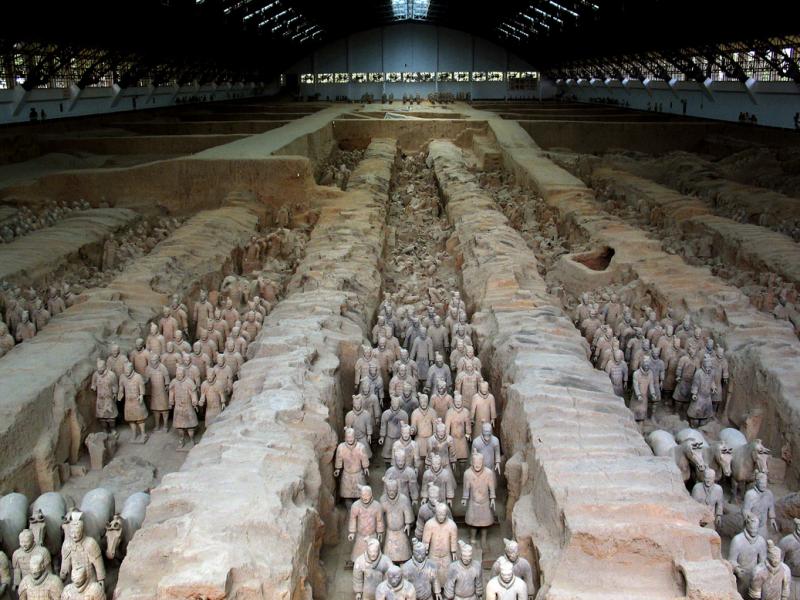An old Chinese saying says, “treat death as life.” In China, rulers took this saying very seriously. After death they were buried with lavish supplies of dishes, food, silk and musical instruments. In earlier times living things such as wives, servants, or pets were also buried with the Emperor, often still alive. The afterlife was so important to people because it was believed to be a prolongation of life. Everything that was buried in the tomb was thought to be a necessity for one who wanted to be prepared for a grand afterlife. In Lintong County, thirty-five kilometers east of the Chinese city Xi’an, a tomb was found that contained a whole army, armed and ready for battle. This army was created for burial complex of the first Emperor of China, Emperor Qin Shihuang .
Qin Shihuang was the first emperor of the Qin dynasty. He was known as a great leader and a conqueror of many lands. He was a destroyer, a builder, and an unforgiving tyrant. Qin Shihuang's accomplishments turned China into a great empire. He formed a centralized government, standardized the Chinese currency and script, and set up a code of laws. He also uniformed the system of measures and built many roads. One of his greatest accomplishments is considered to be constructing and building one half of what today is the Great Wall of China. While the pits with Qin Shihuangs imperial army has been dug up, the actual tomb has not. The supposed contents of the mausoleum are by the tellings of the grand historian, Sima Qian.
In his historical records dated 1 B.C Sima Qian described how the tomb was made and what was put inside it. A project to uncover the tomb though, was started a few years ago but because of a lack of funds, it came to a screeching halt. Yuan Zhongyi is the head of a small group of archaeologists working on the site of the tomb. So far, only a fifth of the fifty-one square mile tomb has been uncovered. Scientific know-how and reliable technology are scarce making it even harder to fund the excavation of the mausoleum.
Many perishable items such as silk and wood have remained inside the tomb for almost two thousand years. The tomb would answer many questions formed by the mysterious terra-cotta army. The army was actually not meant to be seen. It was made to be a “spirit army” and was not intended for display. Inside the pits it was noticed that all the figures face east. They were thought to be this way because Qin had many armies in the east that he had conquered and could have been suspicious of them. He would have wanted to be ready for battle, even in death. All the pits put together represent Qin Shihaung’s actual imperial guards that were stationed at the east of the capitol. The layout of the soldiers and horses were a replica of what Qin’s Imperial army looked like during his reign from 221—210 BC.
The first pit is thought to be the right-wing infantry division. The second was the left-wing cavalry division. Pit number three was the command unit and the fourth pit was thought to be the central force. The first life-size terra-cotta figure was discovered in the 1920’s. A Chinese peasant was digging a well and came upon it. The water disappeared suddenly from the well and the peasant, thinking this was a sign of evil, quickly re-covered what he had dug. The soldier, once again, was buried. It wasn't found again until the 1970’s when archeologists dug up what was soon to be the first actual pit discovered.
The first pit was discovered in 1974. It is the largest of the four pits and covers almost four acres. It is five meters deep and contains eleven parallel corridors and nine access ramps on the sides . There are nearly 6,000 military men inside the first pit. They make up all parts of the army such as bowmen, archers, charioteers, men with arms, and men without arms. They stand in a contemporary military formation made up of 4 parts; the vanguard, the main force, the outer flanks, and the rear guard. The main force contains six horse-drawn wooden chariots with charioteers. Horses that are about 1.5 meters high and 2 meters long lead these chariots. Over the first pit is the exhibition hall of the museum for Qin Shihuang’s terra-cotta warriors. It is about 230 meters long and has a roof made of glass to allow the sunlight to illuminate the army and horses.
Read more at Unsolved Mysteries of Terracotta Warriors


1 comment:
Send some of terracotta warriors the premium chocolate, a bottle terracotta warriors sale wine or flowers
Post a Comment